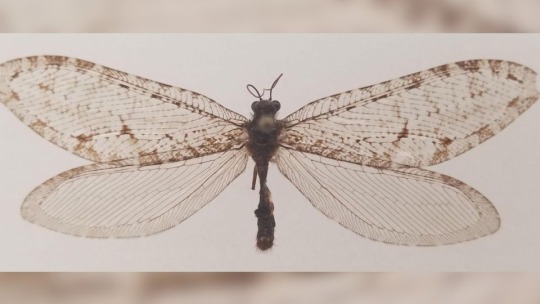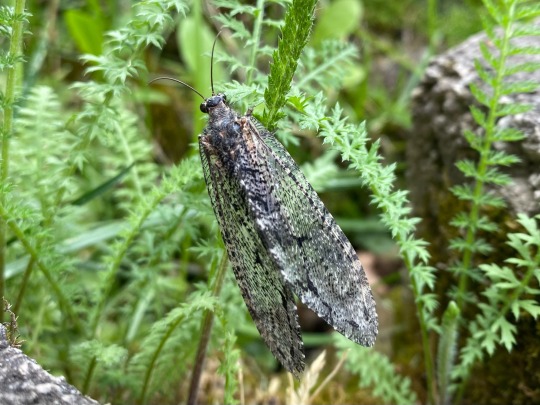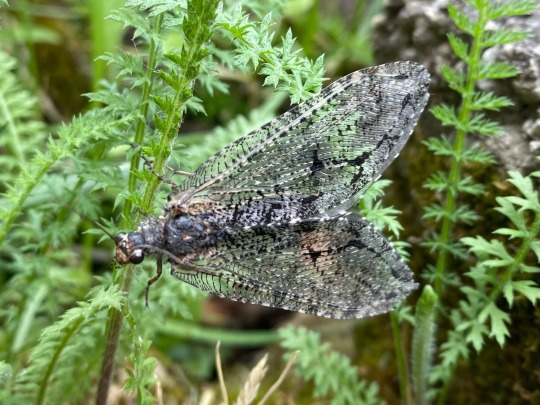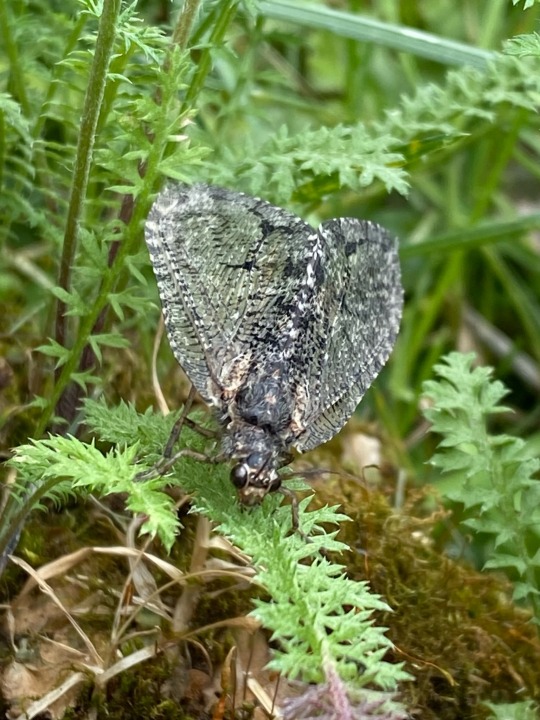#Polystoechotes punctata
Explore tagged Tumblr posts
Text
Giant Lacewing - Polystoechotes punctata
Nearly a year from a previous sight, my dear friend has once again found and shared with me this rather elusive Lacewing. It was found in the same location too! It's sightings like this that give me hope that this specie is still going strong (in some capacity), and that we need to learn more about its behavior and lifecycle. Particularly as details on the latter are minimal, at time of writing. If more specimens of this Lacewing's larvae were easier to discover and monitor over time, it may spell out a multitude of knowledge to be gained over many a scientific journal publishing. At the moment, it seems that they remain elusive due to living beneath soil. Underground, they use their enlarged mandibles to carve into plant roots and feed on material that flows through them. This is quite a shift from the more common Lacewings whose larvae feed carnivorously on soft-bodied insects using their sickle shaped mandibles. Although different, it seems that the strategy finds success since adults are able to emerge into a B.C. summer and use their flight time to secure mates. Such is the goal of the beautiful specimen seen here, and yet its more likely to be mistaken for a Caddisfly or a Moth as it flits its net-veined wings into the night. Hopefully the future gives this insect a boost in renewed interest so that more can be learned about its behavior and lifecycle (especially given its fossilized lineage). Perhaps ideal egg-laying sites would be a good place to start, but with how short-lived the adults are, luck may be a factor.
Video was recorded August 20, 2024 in Squamish with an iPhone 12. Today's specimen has concealed its short abdomen beneath its head. With such large wings and hairs on its body plus a (possible) attraction to outside light, it's no wonder it is sometimes mistaken as a Moth on a porch.
#jonny’s insect catalogue#insect#lacewing#giant lacewing#polystoechotes punctata#polystoechotes lacewing#Ithonidae#neuroptera#squamish#sḵwx̱wú7mesh#august2024#2024#nature#entomology#invertebrates#arthropods#photography#animals
31 notes
·
View notes
Note
Found a creature of all time I reckon, they were interested in the pasta leftovers I was about to microwave.


Sat with me by the oven while I was searching some moth guides but there's . So many moths. Any idea what this critter is? Western Montana
P.S I politely let them stand on the pepperoni slice they landed on, claimed it. I don't think they cared for it though
Insect ID - We. MT, USA:
Hello, yes, this appears to be a Giant Lacewing (Polystoechotes punctata), family Ithonidae, order Neuroptera.
Species Polystoechotes punctata - BugGuide.Net
46 notes
·
View notes
Text
Ein US-Insektologe findet eine #Riesenfliege an der Außenwand eines Walmarts und vergisst sie jahrelang. Sie ist unglaublich selten und war seit mehr als 50 Jahren nicht mehr gesichtet worden – bis ein Wissenschaftler sie 2012 zufällig an der Fassade eines Supermarkts aufsammelte. Inzwischen hat sich bestätigt, dass es sich bei dem Insekt tatsächlich um die #Polystoechotes #punctata, eine Fliegenart handelt.
0 notes
Text
A giant insect plucked from the façade of an Arkansas Walmart has set historic records. The Polystoechotes punctata or giant lacewing is the first of its kind recorded in eastern North America in over 50 years — and the first record of the species ever in the state.
The giant lacewing was formerly widespread across North America, but was mysteriously extirpated from eastern North America by the 1950s. This discovery suggests there may be relic populations of this large, Jurassic-Era insect yet to be discovered, explained Michael Skvarla, director of Penn State’s Insect Identification Lab.
Skvarla found the specimen in 2012, but misidentified it and only discovered its true identity after teaching an online course based on his personal insect collection in 2020. He recently co-authored a paper about the discovery in the Proceedings of the Entomological Society of Washington.
[…]
The fact that a giant lacewing was spotted in the urban area of Fayetteville, Arkansas may reveal a larger story about biodiversity and a changing environment, Skvarla explained. He said that explanations vary for the giant lacewing’s disappearance from North America — and it still largely remains a mystery.
Scientists hypothesize the insect’s disappearance could be due to the ever-increasing amount of artificial light and pollution of urbanization; suppression of forest fires in eastern North America, if the insects rely on post-fire environments; the introduction of non-native predators such as large ground beetles; and introduction of non-native earthworms, which significantly altered the composition of forest leaf litter and soil.
[…]
The mystery remains as to how the insect arrived on the exterior of a Walmart. The fact that it was found on the side of a well-lit building at night suggests that it was likely attracted to the lights and may have flown at least a few hundred meters from where it originated, Skvarla explained. “It could have been 100 years since it was even in this area — and it’s been years since it's been spotted anywhere near it. The next closest place that they've been found was 1,200 miles away, so very unlikely it would have traveled that far.”
The researchers note that they suspect the new specimen represents a rare, surviving eastern population of giant lacewings that evaded detection and extinction.
43 notes
·
View notes
Text

God I love scientists.
2 notes
·
View notes
Text
3 notes
·
View notes
Text
Rare giant Jurassic-era insect was spotted at an Arkansas Walmart#Rare #giant #Jurassicera #insect #spotted #Arkansas #Walmart
Sign up for CNN’s Wonder Theory science newsletter. Explore the universe with news on fascinating discoveries, scientific advancements and more. CNN — An insect found on the side of a Fayetteville, Arkansas, big-box store has been identified as the species Polystoechotes punctata, which belongs to a family of insects that predates the dinosaurs. Michael Skvarla, director of Pennsylvania…

View On WordPress
0 notes
Text
Giant Flying Insect Found On Walmart Building Turns Out To Be Jurassic-era Find
— By Taylor Nicioli | Friday March 3, 2023

The Giant Lacewing, or Polystoechotes Punctata, belongs to a family of insects that predates the dinosaurs. After vanishing in the 1950s, one specimen has been rediscovered in Fayetteville, Arkansas.
An insect found on the side of a Fayetteville, Arkansas, big-box store has been identified as the species Polystoechotes punctata, which belongs to a family of insects that predates the dinosaurs.
Michael Skvarla, director of Pennsylvania State University’s Insect Identification Lab, spotted the Jurassic-era creature, otherwise known as a giant lacewing, on a shopping trip in 2012, when he was a doctoral student of entomology at the University of Arkansas.
“I remember it vividly, because I was walking into Walmart to get milk and I saw this huge insect on the side of the building,” Skvarla said in a statement. “I thought it looked interesting, so I put it in my hand and did the rest of my shopping with it between my fingers. I got home, mounted it, and promptly forgot about it for almost a decade.”
Skvarla initially had misidentified the lacewing as an antlion, a dragonfly-like insect that shares certain features, including long transparent wings, with the lacewing. But after presenting the insect to his online entomology course in the fall of 2020, he realized that what he had all those years was something much rarer and more impressive.
He performed further DNA analyses to confirm the identity of the insect, and the giant lacewing has now become part of the Frost Entomological Museum’s collection at Penn State.
The Giant Lacewing’s Disappearance
The giant lacewing vanished in the 1950s from eastern North America, where it was formerly widespread, according to the paper Skvarla coauthored that was published in the Proceedings of the Entomological Society of Washington. Scientists thought the species had been completely wiped out in the region. The recent discovery of the lacewing in Arkansas is the first record of the species in the state.
“Entomology can function as a leading indicator for ecology,” Skvarla said in the statement. “The fact that this insect was spotted in a region that it hasn’t been seen in over half a century tells us something more broadly about the environment.”
While the mysterious disappearance of the insect is suspected to have been due to efforts to suppress natural forest fires in eastern North America, according to the paper, the bigger mystery is how the insect ended up at a superstore in an urban area of Arkansas.
“It could have been 100 years since (the species) was even in this area — and it’s been years since it’s been spotted anywhere near it. The next closest place that they’ve been found was 1,200 miles away, so very unlikely it would have traveled that far,” Skvarla said. He suggested the lacewing was attracted to the lights and flew at least a few hundred meters from where it had been living.
Skvarla’s find has opened the door for future lacewing discoveries, as insect enthusiasts begin to check their own collections and search for the species in the wild in places they hadn’t thought to look before, said Dr. Floyd Shockley, the collections manager for the department of entomology at the Smithsonian National Museum of Natural History.
“Anytime that you find an insect species not in a place that you’re used to it being, that has a lot of implications for our understanding of that species — the kind of distribution it has, the kind of ecosystem that it might require to complete its lifecycle,” Shockley said. “It means something that we thought was gone, at least from the Eastern US, may still be there, and it’s just hiding in small pockets.”
Shockley also noted the importance of museum collections, such as the one with the Smithsonian or at Penn State, where the lacewing resides, as they “help to capture different snapshots of biodiversity across time and allows us to see what is happening and why it is happening.”
“Everybody always sort of focuses in on the big stuff — big birds and mammals and things like that. But this is an insect world. … We’re just living on it,” Shockley said. “It is really important to have that sort of appreciation. And one of the nice things about insects is that there is so much diversity for you to appreciate, just in your backyard.”
0 notes
Text
Rare giant Jurassic-era insect was spotted at an Arkansas Walmart
Sign up for CNN’s Wonder Theory science newsletter. Explore the universe with news on fascinating discoveries, scientific advancements and more. CNN — An insect found on the side of a Fayetteville, Arkansas, big-box store has been identified as the species Polystoechotes punctata, which belongs to a family of insects that predates the dinosaurs. Michael Skvarla, director of Pennsylvania…

View On WordPress
0 notes
Text






Giant Lacewing - Polystoechotes punctata
This insect was completely new to me and I was very amazed to learn that Canada is home to this specie. Specifically, today's insect is a Giant Lacewing of the family Ithonidae and it certainly appears giant in comparison to other Lacewings featured on the blog. While bigger, it's not as colorful as its distant relatives, its antennae are shorter and its wings appear more cloudy too. The hair on its thorax is far more pronounced compared to more typical species, but all Lacewings have hair along their bodies somewhere. Even Green Lacewings have finer hair lining their wings if you look close enough (too fine for a phone to gauge with precision). As for this specie, if it would be more elongated and thinner, it would more closely resemble an Antlion adult (a fellow Neuropteran). As is, it otherwise has the traditional form of its distant relatives but with a larger wingspan and is far more elusive. It is so elusive in fact that it was thought to be extinct (or at the very least, it vanished) in several regions until it was rediscovered several times over the past 70 years across the United States and parts of Canada!
The genus Polystoechotes may have a reputation for this as its family (Ithonidae) is already composed of many extinct species and those that are still confirmed active have a sporadic distribution. Knowing this, if you think you've found an insect that was presumed to be extinct or vanished, call it in. Especially if the specie is somewhat elusive. I'm happy to report this specimen found in Squamish, B.C. thanks to the vigilance of a dear friend. Perhaps there would be better luck with species like this is we had a better understanding of the habits of their carnivorous larvae...which are also elusive. As well, the adults may not live long beyond mating and laying eggs. Hopefully further investigations can shed new light on this family (at least in North America) if more individuals can be found. As a final note, there is another family of Lacewings known as giants - Osmylidae - which are far more striking than Ithonids, but they don't call North America home. As such, Ithonids are also known by the name "Moth Lacewing", but that name is better suited for the desert-dwelling Oliarces genus. The former could be mistaken for Moths, but the shape of their faces, their net-veined wings and the way in which their wings rest against the abdomen should raise plenty of second-guesses.
Pictures were taken on September 1, 2023 in Squamish with an iPhone X.
#jonny’s insect catalogue#insect#lacewing#giant lacewing#polystoechotes punctata#polystoechotes lacewing#Ithonidae#neuroptera#squamish#sḵwx̱wú7mesh#september2023#2023#nature#entomology#invertebrates#arthropods#photography#animals
4 notes
·
View notes
Text
This rare bug ended up outside an Arkansas Walmart
Picture it—you walk into a typical Walmart in Arkansas on a grocery run, but instead of a traditional Walmart greeter welcoming you in, you find an insect whose origins date back to the Jurassic Period. This sci-fi like story actually happened back in 2012 and luckily the person who spotted the insect is a bug expert. This Polystoechotes punctata, or giant lacewing, was collected in Fayetteville,…

View On WordPress
0 notes
Text
Giant lacewing: Insect thought extinct in eastern US found in a Walmart
The giant lacewing found in Arkansas Michael Skvarla For the first time in more than 50 years, a giant lacewing (Polystoechotes punctata) has been found in eastern North America. The discovery raises new questions about the distribution of the Jurassic-era insect that mysteriously vanished from the eastern seaboard decades ago. The giant lacewing was once abundant across North America, but in…

View On WordPress
0 notes
Text
Rare insect found in Arkansas sets historic record prompts mystery
A giant insect found in Arkansas has set historic records. The Polystoechotes punctata or giant lacewing is the first of its kind recorded in eastern North America in over 50 years. The giant lacewing was formerly widespread across North America, but was mysteriously extirpated from eastern North America by the 1950s. This discovery suggests there may be relic populations of this large insect yet to be discovered.
0 notes
Text




Giant spotted lacewing, Polystoechotes punctata
Found her in a parking garage and carried her outside. She bit me once on the way, it didn't hurt at all but I said ouch so she wouldn't feel embarrassed
1 note
·
View note